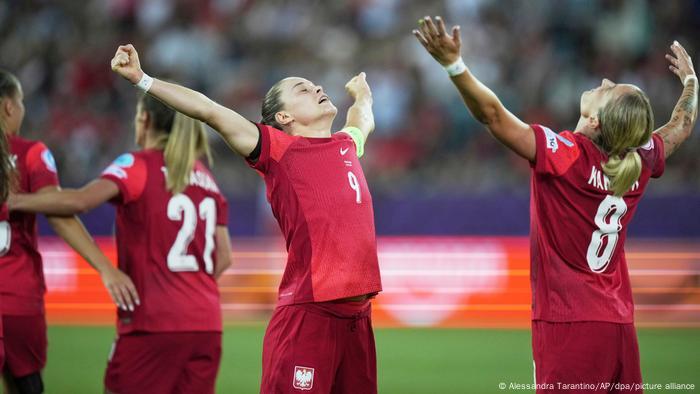Euro 2025: Why Is Eastern Europe Lagging?

The Rise of Women's Football in Europe
Women's football has seen a significant transformation in recent years, with the European Championship (Euro) 2025 marking a pivotal moment. Nadine Kessler, a former Germany international and now UEFA's women's football director, described the tournament as more than just a competition—it is a movement that is reshaping the landscape of the sport. Her words reflect the growing momentum behind women's football across Europe.
UEFA reports that ticket sales for Euro 2025 have already surpassed those of the entire Euro 2022 tournament before the group stage even began. Social media engagement has increased by 55% compared to previous events, and the prize pool has jumped by 156%, reaching €41 million ($47.5 million). These figures highlight the increasing popularity and financial investment in women's football.
However, despite these positive trends, the region of Eastern Europe has struggled to make a significant impact in the tournament. Only one team from this area—Poland—made it to Euro 2025, and only three teams from the region have ever qualified for any European Championship. This contrasts sharply with men's football, where 11 of the 24 teams at the 2024 Men's Euros were from Eastern Europe.
Croatia, for example, had a strong presence in men's football, reaching the final in the 2018 World Cup and the semifinals in 2022. However, their women's team has yet to qualify for a major tournament. This disparity raises questions about the challenges faced by women's football in the region.
Cultural Barriers and Investment Gaps
Goran Ljubojevic, former coach and current sporting director of ZNK Osijek, a top Croatian women's club, believes that cultural norms are a major obstacle. He points out that in many Eastern European countries, there is a lingering belief that football is a "man's game." This mindset is reflected in the European Union's Gender Equality Index, which shows that no Eastern European countries are above the EU average in gender equality.
Ljubojevic also highlights the lack of investment in women's football. While clubs in the region started developing women's programs in the 1990s, funding has remained limited. He notes that even the most successful teams, like ZNK Osijek, struggle to attract large crowds, with home matches drawing only around 300 spectators.
Despite these challenges, Ljubojevic remains optimistic. He believes that increased exposure through tournaments like the Euros and the 2023 Women's World Cup in Australia and New Zealand is gradually changing perceptions. People are beginning to realize that women's football has a dedicated fanbase and can generate significant interest.
Infrastructure and Financial Challenges
Professor Dariusz Wojtaszyn from the University of Wroclaw in Poland acknowledges the progress made in recent years but emphasizes the need for continued investment. He notes that women's football budgets in Central and Eastern European (CEE) countries have increased significantly, often by over 100%. This growth, he says, is largely driven by initiatives from UEFA and local football associations.
UEFA has implemented new schemes to support women's football in the region, and these efforts are starting to bear fruit. The organization stated that its revamped competitions, including the Champions League and Europa League, ensure that all teams have equal access to opportunities. They also highlighted the impressive performances of Eastern European clubs and national teams at various levels.
However, Wojtaszyn points to historical and political factors that have hindered the development of women's football in the region. Under communist regimes, while gender equality was officially promoted, traditional social structures persisted. The collapse of state-sponsored systems in the 1990s led to economic difficulties for football clubs, making it harder for women's teams to secure funding and resources.
More recently, the rise of right-wing parties in countries like Romania, Poland, Slovakia, and Hungary has reinforced traditional values, further complicating the path for women's football.
A Future of Growth and Opportunity
Despite these obstacles, there is hope for the future. Ljubojevic believes that with proper investment in coaching, infrastructure, and player salaries, women's football in the region can flourish. He points to the potential talent pool, similar to that of men's football, and stresses the importance of providing the right support.
Poland, for instance, expects a surge in participation following its Euro 2025 campaign. National team head coach Nina Patalon predicts a tenfold increase in female players, from 30,000 to 300,000. Ljubojevic believes that Croatia and other countries in the region could benefit from a similar boost if they take the sport seriously.
He envisions a future where Croatia hosts a major tournament, stating that it is possible if the federation and country commit the necessary resources. Women's football, he argues, is the new wave, and the region must ride this momentum to achieve long-term success.
As the sport continues to evolve, the challenge remains to overcome cultural barriers, secure funding, and build the infrastructure needed to support women's football in Eastern Europe. With sustained effort and investment, the region could soon see its teams compete on the global stage.
Post a Comment for "Euro 2025: Why Is Eastern Europe Lagging?"
Post a Comment